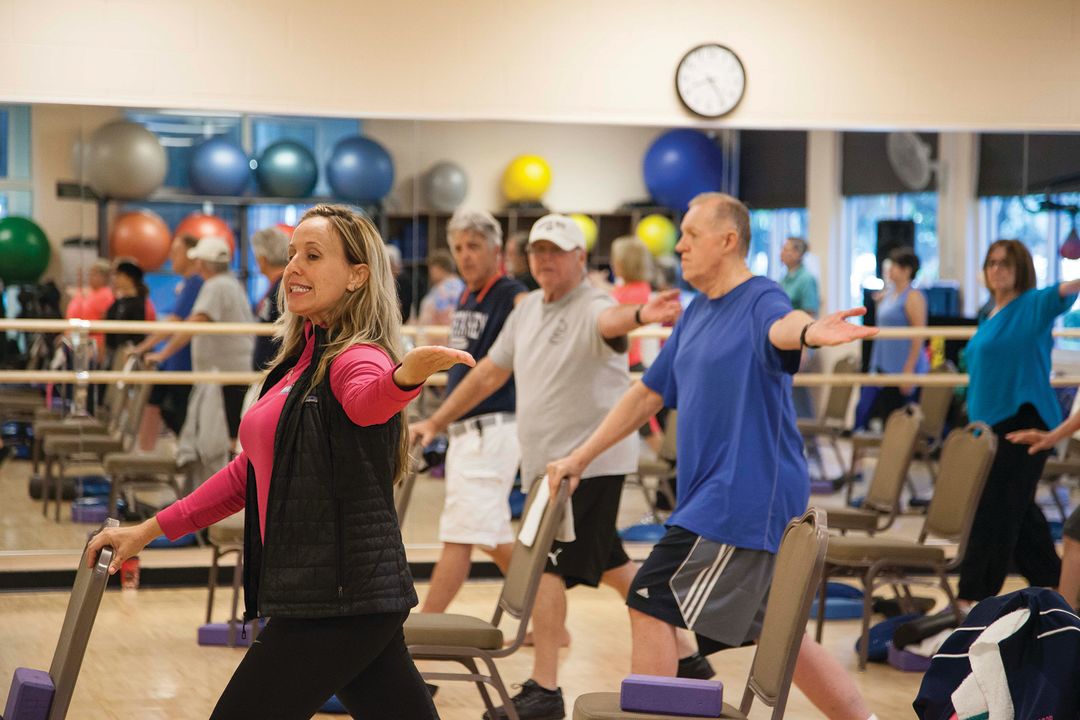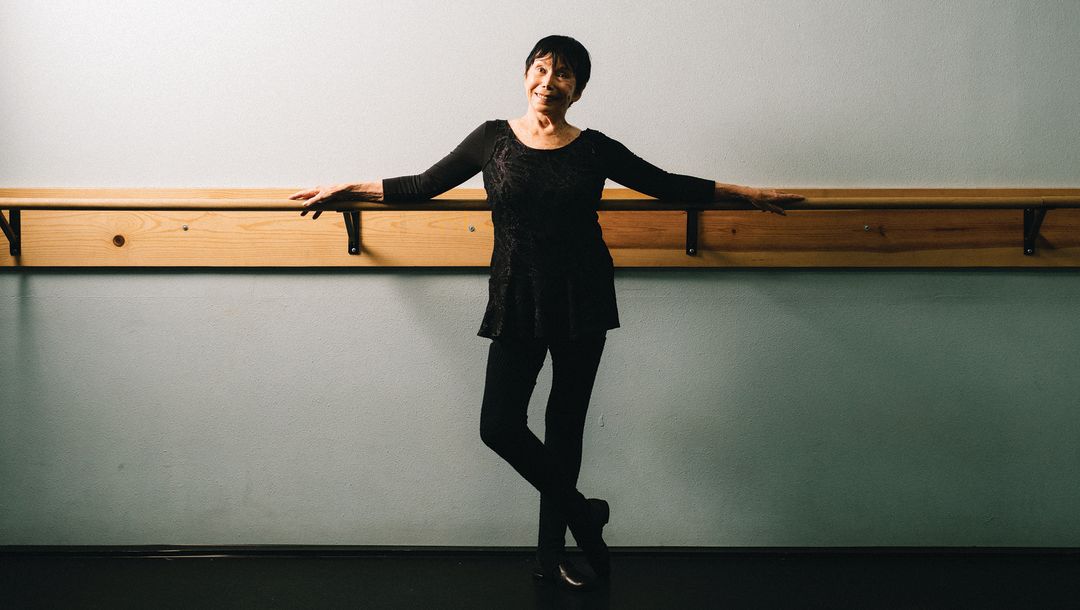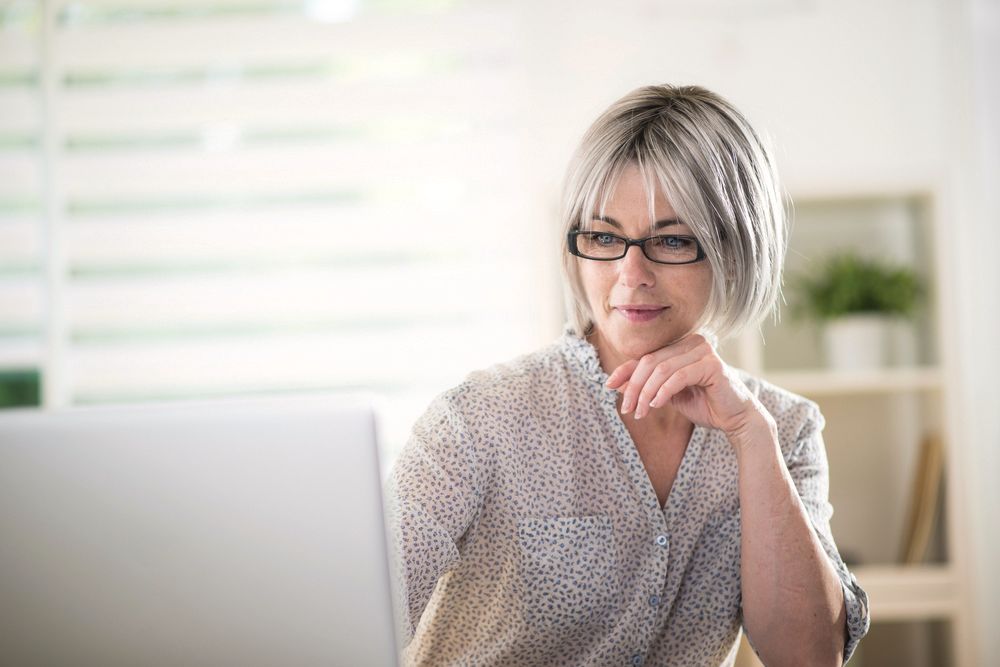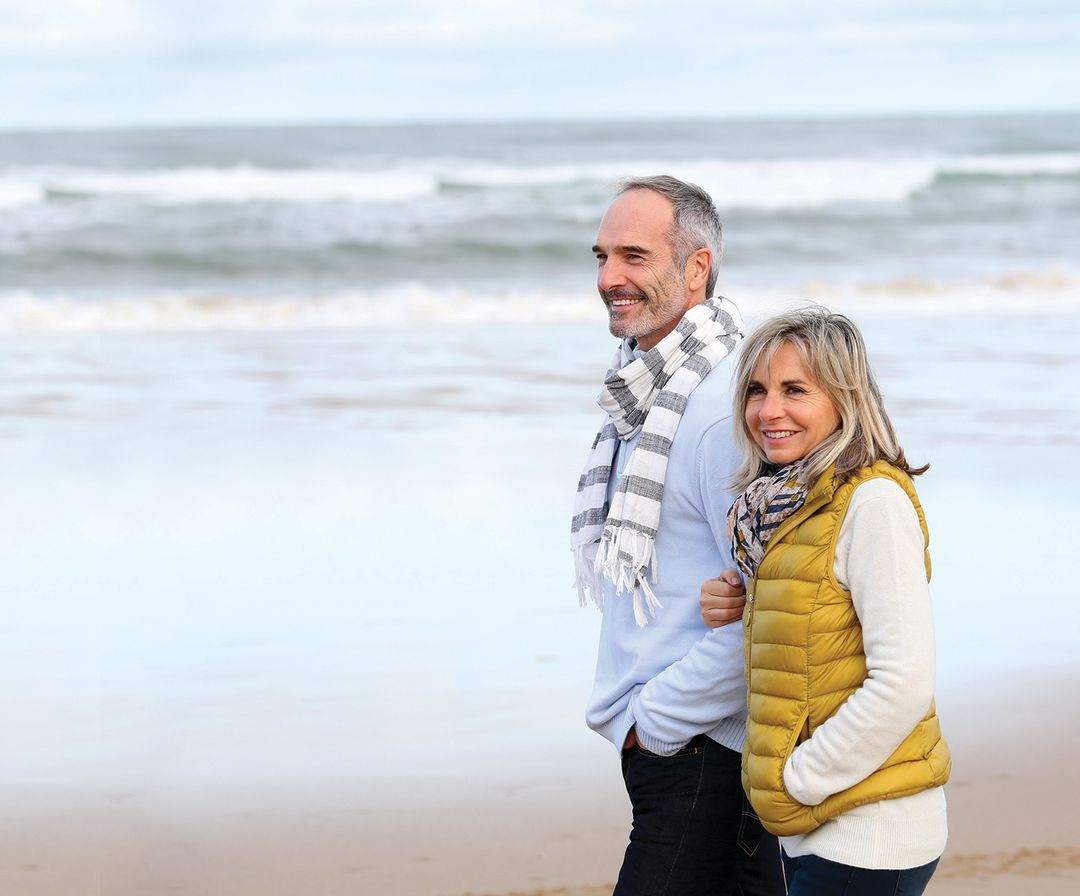How to Look and Feel Younger

A movement class at HealthFit.
Image: Matthew Holler
At the age of 86, Renate Suttle heads to the Sarasota Cuban Ballet School five times a week. On Monday and Wednesday mornings, she teaches adult ballet classes for an hour and a half. On the other three days, she takes upper-level classes with women decades younger. Slim, graceful, with ramrod-straight posture and energy to spare, Suttle could pass for someone 20 years younger.
“I started ballet when I was 8, and I never stopped,” she says about her early years touring Europe with a Swiss dance company and later teaching dance at an arts gymnasium in her native Germany. “It’s a fountain of youth.”
Suttle starts every morning with a 55-minute power walk; eats a healthy, disciplined diet of protein and vegetables along with a mid-afternoon cookie and cup of coffee; naps for an hour and a half every day; and has two glasses of chardonnay—one in the evening and one at lunch. (“Why should I wait? And for what?” she says with a laugh.)

Renate Suttle credits her lifelong love of ballet for her healthy longevity.
Image: Everett Dennison
Aging is inevitable. (Consider the alternative!) But we can slow it down and face our older years looking and feeling energized, with fewer health issues, if we follow some basic advice that Renate Suttle long ago figured out: exercise, eat well, get enough sleep and reduce stress.
In a groundbreaking (and New York Times best-selling) new book, The Telomere Effect, a Nobel Prize-winning biologist, Elizabeth Blackburn, and co-author Elissa Eppel report that aging can be delated by strengthening our telomeres, the tiny tips at the end of chromosomes that protect them from wearing down.
“When telomeres can’t protect chromosomes properly,” Blackburn told The Guardian in a recent interview, “cells can’t replenish and they malfunction. This sets up physiological changes in the body, which increase risks of the major conditions and diseases of aging: cardiovascular disease, diabetes, cancer, a weakened immune system and more.”
And how can we strengthen telomeres? Blackburn and Eppel present a wealth of scientific evidence showing that exercise, healthy eating and mental and social engagement help keep telomeres healthy and chromosomes vital. In other words—strong telomeres keep us feeling and looking young even in our later years.
Luckily for us, we are in the perfect place to follow that prescription. The same attributes that caused U.S. News and World Report to name Sarasota the No. 1 place to retire in 2018 and Gallup Healthways in 2015 to rate us the No. 1 city for well-being encourage healthy behavior. The moderate climate keeps us outdoors and active; world-class artistic and educational experiences stimulate our minds; a burgeoning foodie scene with loads of fresh, farm-to-table options and top-quality restaurants of every ethnic persuasion make healthy eating easy. (Don’t take our word for this; Conde Nast Traveler named Sarasota one of the nation’s top small food cities in 2016.) And everywhere you look, there are friendly neighbors with a welcoming attitude who say if you want to help better our community, jump right in.
We’ve scouted out all sorts of ways to refresh and revive your body, mind and soul in our city. Let’s get going.
Keep Moving
Like the plucky little fish in Disney’s Finding Nemo and Finding Dory, who sings “just keep swimming,” a central key to staying youthful is moving your body.
Exercise helps you manage your weight, increase bone density, maintain muscle mass and flexibility. “All these are harder to maintain with age; all are very important in living a longer, healthier life,” says Sarah Schmitz, fitness supervisor at HealthFit, Sarasota Memorial Hospital’s medically oriented fitness center. And exercise has also been shown to ward off chronic diseases. There are other indispensable side effects, says Schmitz: Exercise energizes you, boosts your mood and keeps you from acquiring that stiffness and stooped gait that telegraphs aging. And, if you exercise at a gym, it improves your social life, too.
Dance is a joyous way to look and feel younger. Renate Suttle touts the mental concentration it takes to conquer complicated ballet combinations, as well as the exhilaration of moving to the music. “It’s better than a psychiatrist; you forget everything about the world,” she says.
Don’t fret if you’re not a ballerina; it turns out that frequent freestyle dancing—getting out on the dance floor and letting go—is the physical activity that most reduces the risk of dementia, by an impressive 76 percent, according to a two-decade-long study by the Albert Einstein College of Medicine reported in the New England Journal of Medicine. Freestyle dancing increases your cognitive reserves and forces your brain to rewire the neural pathways through which your neural synapses go. The better connected the neurons, the healthier the brain. Motown medley, anyone?
Improving your balance will help keep you from being one of the 2.8 million older adults who each year are treated in the emergency room for broken limbs, pelvises, hips and other fall-related injuries. The Centers for Disease Control reports that falling is the leading cause of injuries among people 65 and older. And once someone falls, says Amanda Harrison, program director of the Ready & Steady program at the Pines of Sarasota, they are two to three times more likely to fall again. In an instant, people can go from leading independent, active lives to being bedridden, disabled and dependent on others. “It only takes that one bad fall to change someone’s life,” Harrison says.
You may be familiar with the Ready & Steady balance assessment test from local ads that feature comedian and Sarasota resident Dickie Smothers. The test is free, and more than 750 people have taken it since the Pines launched it in 2015 after seeing a lot of people in their 60s coming to it for rehab after breaking bones in what they described as “silly” falls. A 15-question survey, a few moments on a gently moving platform and a timed agility test are all that it entails. If it’s determined you’re at low risk for falls, you’re referred to community programs with exercise programs to keep you that way. If you’re at high risk, physical therapy is recommended.
“I liken it to you getting your eyes and hearing checked,” says Harrison. “After a while you decide to get your hearing checked every year. You should get your balance checked, too.”
The Friendship Centers, with locations in Sarasota and Venice, offer balance movement classes that teach participants how to walk properly and what to do if they fall.
The ancient Chinese practice of tai chi, with its 108 slow and meditative full-body movements, is an excellent way to improve balance—and reduce the risk of falling, too, by 45 percent, according to the New England Journal of Medicine. The Taoist Tai Chi Society’s Sarasota Center offers easy-to-follow classes seven days a week.
Yoga helps keep you steady, and flexible, too. There are more than two dozen yoga studios in our area, even paddleboard yoga and yoga on the beach. Check out the Sarasota Family Y’s classes here.
Sleep
Remember going to bed as a kid? You would shut your eyes and in what seemed like an instant, wake up eight or nine hours later raring to go. Those blissful nights are just a memory to most adults. The older we get, the more we struggle with sleep. Many older adults wake throughout the night, sometimes for hours at a stretch.
Some tell themselves that older people just don’t need as much sleep. But that’s not true. Matthew Walker, the director of the Center for Human Sleep Science and author of a new book, Why We Sleep, said in a recent interview on NPR’s Fresh Air, “We need just as much sleep in our 60s, 70s [and] 80s as we do when we’re in our 40s.” During sleep—especially the deepest stage of sleep, the non-rapid-eye-movement stage—our bodies rebuild and repair. But although we may still need sleep, we’re unable to get enough of it—and that is a major cause of disease, aging and even reduced life span. By their 50s, most people have lost as much as 50 percent of the deep sleep they had as teenagers. “By age 70, you may have lost almost 90 percent of that deep sleep,” Walker said.
Sarasota sleep expert and author Dr. Matthew Edlund agrees. Seven or more hours a night of actual shut-eye, not just time in bed, is essential for our bodies, he says. “Even short amounts of sleep deprivation, an hour or two, lead to more heart disease, Alzheimer’s, diabetes,” he says. And it affects every part of your body. For example, skin grows much faster while you’re asleep—something of interest to anyone who wants fresh-looking, healthy skin.
Yikes. How do you fight biology? Dr. Edlund’s orders:
• Go on an electronic diet 30 to 60 minutes before sleep and during sleep, too. “Turn off the lights, turn off your cellphones except for true emergency situations [you can program them].”
• Be regular in when you go to bed and when you get up.
• Recognize that sleep is fun. “Use that time for the enjoyment that comes from dreaming and remaking and reorganizing your body while you’re not looking,” says Edlund.
In addition, Walker advises avoiding alcohol, which fragments sleep, and either reading when you wake up at night or trying meditation—which he calls “very effective.” (Learn how at Sarasota Mindfulness Institute.)
Protect Your Skin
If learning that skin cancer is diagnosed 5 million times every year in the U.S. isn’t enough to have you running for a tube of sunscreen, consider this: Nothing accelerates aging more than being out in the sun, says Moffitt Cancer Center skin cancer expert Dr. Kenneth Tsai. The tans many baby boomers worked to get in their youth have left a legacy of wrinkles and age spots along with sometimes deadly skin cancers.
How much sunscreen should you use to block out those evil U.V. rays? A shot glass full of SPF 30, says Tsai—a larger amount than most people apply. And be sure to reapply it often, especially if you’ve been in the water. Look for brands that have zinc oxide as the active ingredient.

Creative opportunities abound in Sarasota, like this class at Carla’s Clay.
Image: Matthew Holler
Feed Your Head
Parts of the brain shrink as we age, says Cheryl Brandi, nurse practitioner at Sarasota’s Roskamp Institute Clinic, which is researching possible cures for Alzheimer’s disease. “The hippocampus, which is responsible for converting short-term memory into longtime storage. shrinks; there are narrower arteries and fewer new capillaries, so blood flow is reduced and inflammation increases,” she says. In addition, even healthy brains have some of the plaques and tangles associated with Alzheimer’s disease and some damage by free radicals.
The life choices critical for brain health are essential for heart health, too, she counsels patients: avoiding obesity, high blood pressure, heart disease, diabetes, poor sleep habits and sleep apnea. “Heart healthy is brain healthy,” she says.
Besides all-important exercise, Brandi offers other suggestions:
Learn something new. We’re lucky; our community is full of opportunities to stretch our brains. The Ringling College Lifelong Learning Academy and Longboat Key Education Center offer courses in areas as disparate as art appreciation and economics. Learn French, sharpen your acting chops and study web design (and much more) at the Adult and Community Enrichment (ACE) program at Suncoast Technical College. Mote Marine Laboratory just launched a 10-session marine science course for adults. And many other nonprofit groups, like Ringling College Library Association’s Town Hall series, bring topical speakers to town. “Push yourself to learn something new that’s challenging,” says Brandi.
See a play. Or go to an orchestra or jazz concert, take in a Gallery Walk with a Ringling Museum curator, or maybe even try a pottery class at Carla’s Clay. Participating in the arts in this arts-rich town is not only good for your psyche, it’s good for your brain.
Play bridge. Warren Buffett got it right—again. Playing complex games that require concentration like bridge (and mahjong) keeps you mentally in the game. According to AARP, in a 2014 University of Wisconsin study, “Researchers discovered that the frequency of playing games is associated with greater brain volume in several regions that are affected by Alzheimer’s disease. Those who played more frequently also scored higher on cognitive tests.”
One good place to start: Sarasota’s In Between Bridge Club, which is one of the largest bridge clubs (out of 3,000) in the American Contract Bridge League, hosts bridge games six days a week at its headquarters on Bee Ridge Road.

Mastering new technology will help you stay connected and keep learning.
Image: Shutterstock
Embrace changing technology. Mastering new technology, from smart phones to Facebook, can help you connect with far-flung family, stay up-to-date on the latest news and save money when you search for digital deals. Plus, your grandkids will think you’re super-cool. The Sarasota Technology Users Group (thestug.org) has been training members on all things tech since 1982. Among its forums and classes: editing and formatting a Word document, iPhone and iPad basics, and using Google Drive. Club president Ann Ross, who’s full of energy in her mid-80s, says STUG’s 400 members, most of them in their 70s, don’t want to be left behind in the world. “Keeping up with technology makes them feel like they’re part of the continuing society in which they live,” she says.
Get your hearing checked. Roskamp’s Brandi finds that a lot of seniors don’t want to wear their hearing aids, yet the relationship between hearing and cognition is strong. “When the brain has to focus on hearing, it loses the ability to process other things in the environment,” she says.
Have Fun
It sounds so simple, but in our busy lives, how often do we program time for fun and friendships? Social isolation is not brain healthy, says Brandi. When you approach life with the humor and happiness that come with friendship, “You get those good-mood chemicals,” she says. It’s a good idea to make friends with younger people as you age, too. They’ll keep you fresh and up-to-date while you can provide them with wisdom and perspective.
And find things that make you laugh. According to the Mayo Clinic, laughter stimulates your organs, activates and relieves your stress response, and soothes tension.
If you’re one of the region’s many seniors who can no longer drive, connect with iTN Suncoast, a nonprofit, volunteer-led organization that provides transportation for people like you. It recently launched Let’s Go Places, a series of monthly events that brings people together for affordable restaurant, shopping and entertainment outings. Learn more here.
There are countless ways to find friends and fun in our region. Take up pickleball, enroll in an improv comedy class at Florida Studio Theatre, join a club—we have hundreds of them here. The first—and hardest—step is to make pleasure a priority.

Image: Shutterstock
Stretch Your Soul
Go outside. Surrounding yourself with nature is an instant stress-reducer and mood elevator. Our mild winters let you play outdoors much of the year while your buddies in Buffalo are freezing. Almost every day of the year here is a good day to take a sunset beach stroll or picnic at Myakka River State Park, and The American Littoral Society’s Sarasota Bay chapter offers guided kayak trips on our rivers and bays and educational eco-tours aboard the Carefree Learner floating classroom. Ecko Tours offers half- and full-day excursions like ranger-led bike rides at Oscar Scherer State Park. You can spend a few hours or an entire day biking along the Legacy Trail, which stretches from Sarasota to Venice. And imagine the sense of accomplishment you’ll feel when you join the throngs of walkers, joggers and bicyclists who conquer the Ringling Bridge.
Volunteer. Sarasota is famous for its legions of volunteers. Consider retirees Steve and Sharon Dickman. They usher at nearly every theater in town. Steve has appeared onstage as a supernumerary in 29 Sarasota Opera productions—he had six minutes of fame last fall as a bewigged waiter in La Traviata—and he’s the human underneath Mote’s Gilly the Shark mascot costume. Sharon, a former New York City elementary school teacher, volunteers at Tatum Ridge Elementary. They both work with developmentally challenged adults in the Kaleidoscope program at The Haven and Easter Seals, a volunteer role Steve calls “incredibly enriching.” And every Thursday afternoon for 14 years, Steve has volunteered as a biologist’s aide on the Sarasota Bay Explorer nature cruise boat.
When they were honored last fall with the 2017 Volunteer Arts Leadership Award, Steve, 74, said, “Whatever we’ve given to Sarasota we’ve gotten back many times over. Fulfillment, satisfaction, lots of new friends, and we’ve gotten to see great operas, plays, concerts and ballets. To be given an award for it is the icing on a very large and incredibly delicious cake.” And what’s more, he adds, “It absolutely keeps us young, 100 percent.”
A good way to find volunteer opportunities is online at volunteermatch.org.
Give to others. Sarasota philanthropist Betty Schoenbaum, who turned a spry 100 last September, is among the many people who share their wealth as well as their time with the nearly 2,000 nonprofit organizations in our area. A frequent public speaker, she delights in telling audiences, “The joy of living is the joy of giving.” Studies show she’s right. Philanthropists at every income level score higher on happiness, and they live longer, too. (Schoenbaum likes to tell audiences, with a twinkle in her eye, “They also have better sex!”)
Go to thegivingpartner.guidestar.org, a registry of hundreds of nonprofit organizations that was created by the Community Foundation of Sarasota County to provide public information on their missions and governance.



